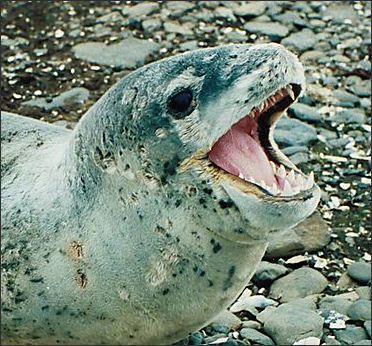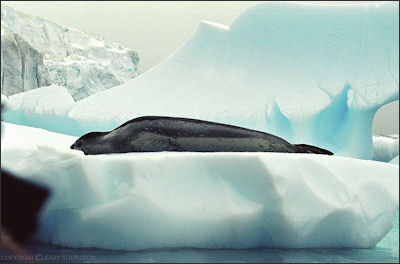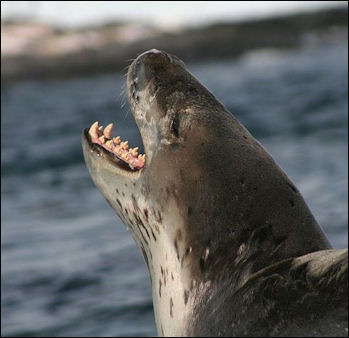LEOPARD SEALS

leopard seal Leopard seals (Scientific name: Hydrurga leptonyx) are one of the world’s most dangerous animals. Weighing up to 380 kilograms (840 pounds), they rarely attack humans but they have and killed some. Their lifespan in the wild is estimated to be 26 years, with a high of 30 years. The scientific name of leopard seals, Hydrurga leptonyx, literally translated means 'slender-clawed water-worker'. Their common name comes from their patterned skin.[Source: Taiyler Simone Mitchell, Business Insider December 24, 2022]
Leopard seals are apex predators at the top of the Antarctic food chain. Their only known natural predators are killer whales, however leopard seals are rarely eaten. Leopard seals themselves are notorious predators who feed on penguins, fish, squid, krill and other seals, mostly crabeater seal and fur seal pups. They are the only seals that to regularly hunt warm-blooded prey and kill other mammals and seals. Despite their reputation as fearsome predators, leopard seals feed primarily on krill, using their lobodont teeth to filter these small crustaceans from the water. They also eat fish and squid. [Source:Paul Nicklen, Kim. Heacox, National Geographic, November 2006]
Leopard Seals are found throughout the Antarctic and nearby islands and have been seen as far north as Australia, South America and South Africa. They reside mostly on and around the ice packs but are occasionally seen on Antarctic beaches and subantarctic islands if there is enough ice substrate nearby. These seals roam a huge area. Little is known about their biology and even their numbers. Estimates range from 200,000 to 400,000. Because they eat whatever is available scientists track their diets to get a sense of the available food supply in an area. By chemically analyzing their whiskers, scientists can determine roughly three years of feeding patterns.
Leopard seals are not endangered. They are designated as a species of least concern on the International Union for Conservation of Nature (IUCN) Red List and have no special status according to the Convention on International Trade in Endangered Species (CITES). There are few interactions between humans and leopard seals. A decline in Antarctic pack ice, possibly resulting from global warming, may impact this species.
Related Articles: CATEGORY: SEALS: ioa.factsanddetails.com; Articles: SEALS: CHARACTERISTICS, SENSES AND WHISKERS ioa.factsanddetails.com; SEALS: HISTORY, BEHAVIOR, DIVING, FEEDING, REPRODUCTION ioa.factsanddetails.com; SEAL AND SEA LION ATTACKS ON HUMANS ioa.factsanddetails.com ; SEAL SPECIES ioa.factsanddetails.com ; SEA LION SPECIES ioa.factsanddetails.com
Websites and Resources: Animal Diversity Web (ADW) animaldiversity.org; National Oceanic and Atmospheric Administration (NOAA) noaa.gov; Fishbase fishbase.se; Encyclopedia of Life eol.org; Smithsonian Oceans Portal ocean.si.edu/ocean-life-ecosystems ; Monterey Bay Aquarium montereybayaquarium.org ; MarineBio marinebio.org/oceans/creatures
Leopard Seal Characteristics
 Leopard seals are by far the largest of the antarctic seals, reaching a length of almost four meters and weighing over half ton. Females are larger than males. Males can grow up to three meters (10 feet). Females are even larger, growing up to 3.8 meters (12.5 feet). Males and females range in weight from 300 to 500 kilograms (660 to 1100 pounds). Leopard seals are endothermic (use their metabolism to generate heat and regulate body temperature independent of the temperatures around them). [Source: Anna Hill, Animal Diversity Web (ADW) /=]
Leopard seals are by far the largest of the antarctic seals, reaching a length of almost four meters and weighing over half ton. Females are larger than males. Males can grow up to three meters (10 feet). Females are even larger, growing up to 3.8 meters (12.5 feet). Males and females range in weight from 300 to 500 kilograms (660 to 1100 pounds). Leopard seals are endothermic (use their metabolism to generate heat and regulate body temperature independent of the temperatures around them). [Source: Anna Hill, Animal Diversity Web (ADW) /=]
Leopard seals have extremely large heads which look too big for their slender bodies. Despite this they move with amazing speed and agility. Their overall body shape is long and slender. Their coloring varies dorsally (back) to ventrally (front) with a dark grey back, a silvery grey underside, and dark and light spots throughout the entire body.
The snouts of leopard seals are long. Their head, mouth and teeth are well-designed for catching and handling prey. They have sharp front canines and incisors designed for capturing and shredding prey and back molars with sharp edge for grasping and cutting, but also with interlocking cusps to sift krill.
Leopard Seal Behavior
Leopard seals are diurnal (active mainly during the daytime), motile (move around as opposed to being stationary), migratory (make seasonal movements between regions, such as between breeding and wintering grounds) and solitary. The home ranges of leopard seals are confined mostly to the pack ice, because of mating. [Source: Anna Hill, Animal Diversity Web (ADW) /=]
Leopard seals are a mostly solitary species excluding mating and nursing periods. As mating season approaches, the density of seals on and around packs of ice increases. Density on pack ice also increases when pups are born, as that is where mothers give birth and nurse their young. Otherwise leopard seals predominately inhabit the water.
Leopard seals are much more agile in the water than on ice or on land, and water is where they spend much of their time. They feed on species that reside in surface waters of the ocean, and thus are found primarily in these waters. Throughout the year are also found on the nearby subantarctic islands in moderately low numbers. However, this greatly increases during the winter months during the seal migration period.
Leopard seals communicate with sound and sense using touch, sound and chemicals detected by smelling. Not much is known regarding communication among leopard seals. However, males are known to vocalize just prior to and during the mating season. It is presumed that these sounds are used for mate attraction. /=\
Leopard Seal Mating and Reproduction

leopard seal Leopard seals are viviparous, meaning they give birth to live young that developed in the body of the mother, and engage in seasonal breeding. Females breed once a year. The breeding is in the early Southern Hemisphere winter and lasts from December to early January. The number of offspring is usually one. The average gestation period is nine months. On average females reach sexual maturity at age four years. Males do so at 4.5 years.[Source: Anna Hill, Animal Diversity Web (ADW) /=]
Little is known about leopard seal mating systems. They inhabit an extreme environment and making direct observations is difficult. Much of what is known has been observed from captive individuals. Leopard seals generally live a solitary lives with the exception of when they come together for the brief mating period. Mating occurs shortly after the pups are weaned.
Little is known about how male and female leopard seals come together to mate, but vocalization is thought to play a role as males become highly vocal during the breeding season. These seals are thought to be polygynous (males having more than one female as a mate at one time). Mating occurs in the water among captive seals. This believed to be the case in the wild too. After mating the female is left alone by the male.
Leopard Seal Patenting and Offspring
Parental care is provided by females. During the pre-birth and pre-weaning stage provisioning and protecting is done by females. Males do not provide do not engage in any parental activities after they have mated with a female.
Birth of leopard seal pups generally occurs between late October and November, with newborn pups measuring on average 1.2 meters (almost 4 feet) in length. For the next four weeks, the mother nurses her pups on an ice flow.
On the ice floes of Antarctica mother seals are seen nursing and protecting their young. After four 4 weeks, the pup is weaned and shortly after females begin mating again. After the weaning period, there is not much known about leopard seal development. Juvenile leopard seals have, however, been observed in relatively large numbers on the nearby subantarctic islands.
Leopard Seal and Penguins

Leopard seal
For some leopard seals, penguins are their primary prey. They often cruise along the edges of ice flows, looking for penguins they can take. Attacking leopard seals thrust out of the water when attacking penguins. Their strategy is to knock over the penguins like bowling pins A favorite target in the austral summer is newly fledged penguins going into the sea for the first time.
Leopard seals are a penguin's greatest worry. As many as one in every three penguins may be taken these nine-foot-long predators. Peterson once came across a group of penguins who sought refuge on an ice flow, "Two of the birds were mutilated and bloody," he said. "The predatory seal, lurking under the lip of the ice, surfaced two or three times, watching us. Then an incautious penguin plunged in and swam for shore. Quick as a flash the leopard seal grabbed [the penguin] and thrashed it this way and that, literally shook the body out of the skin. A leopard seal will feed on krill, by when near a penguin colony it likes its krill pre-processed."
Penguins are known to leap into the boats of tourists when pursued by a leopard seal. On land or ice where the seal isn't so adept penguins will strut within a few feet of the predator. National Geographic photographer Paul Nicklen witnessed leopard seals take several penguin chicks. He said what the seals prized most was a penguin stomach filled with krill and that it took them significantly more time to catch adult penguins than their young. On one attack he wrote in National Geographic, “In a death shake, the large female shred a penguin chick by whipping it from side to side...All I saw was a splash and storm petrels and gulls gathering for scraps...the large female dived to eat her prey.”
For Emperor penguins, life is safer in a colony or a group, where predators are few and if one is near by the chances are it will get somebody else. Glenn Hodges wrote in National Geographic, The danger of ambush by leopard seals is greatest when entering the water, so penguins sometimes linger at the edge of an ice hole for hours, waiting for one bold bird to plunge in. Without the safety of numbers, a lone penguin corkscrews around get a 360-degree view of its surroundings. Emperors can bolt away for any number of reasons, as Nicklen discovered when he spooked this group. “A tenth of a second after I took this picture, all I could see were bubbles.” [Source: Glenn Hodges, National Geographic, November 2012]
Leopard Seal Attacks on Humans

leopard seal
The crew of the famous Shackleton expedition in 1914 had several encounters with leopard seals. Thomas Orde-Lees was skiing across an ice flow when a leopard seal emerged between two ice flows and lunged after him. Orde-Lees managed to escape only to have the seal track him from below the ice and attack again from ahead. Orde-Lees shouted for help. Another member of the expedition, Frank Wild, shot the leopard seal dead.
Describing close encounters with a leopard seal Paul Nicklen wrote in National Geographic, “I expected this 12-foot-log female to flee with her catch, a live penguin chick, but instead she dropped it on my camera. Then she opened her mouth and engulfed the camera — and most of my head. After 45 minutes of more threats, she finally relaxed and ate.” On another encounter he wrote, “In a lethal game of cat and mouse, the large female...caught and released this penguin chick...for more than an hour, repeatedly presenting it to me. When I ignored her, she blew a stream of bubbles from her nose in a threat display and tried again...More frightening than the canines of the large female was the deep jackhammer sound she let loose that rattled through my chest.”
Goran Ehlme, a Swedish cinematographer who has spent years with leopard seals, said their reputation for fierceness is somewhat undeserved. Mostly they are just inquisitive he said. “It makes a better story to tell about a ferocious animal than it does tell about a curious one,” he said. “People tend to judge animals in frightening moments. But these seals, they are mostly curious.” Even so Antarctic research stations advice anyone not doing research to stay out of the water if they sea a leopard seal.
Leopard Seal Kills a Biologist
In July 2003, Kirsty Brown, a 28-year-old marine biologist, was snorkeling off the Antarctic Peninsula, when she was grabbed, pulled down and drowned by the leopard seal, her colleagues worked for an hour to revive her, but could not. There had been reports of leopard seals harassing people and puncturing inflatable boats but his was the first report of a human fatality by a leopard seal.
According to Reuters Brown was attacked by a leopard seal while she carried out research close to the Rothera research station, about 800 miles south of the Falkland Islands. Horrified colleagues watched as Brown, a qualified diver, was pulled underwater and drowned by the seal.
Professor Chris Rapley, director of the British Antarctic Survey (BAS), said Brown's death had shocked her colleagues. "In 30 years we have never experienced anything like this," a BAS spokesman told the Daily Telegraph newspaper. "Leopard seals are incredibly inquisitive, but are not normally aggressive. If a diver can see a leopard seal, then they will not go in the water because there is a small risk. But to our knowledge, this has never happened before."
Image Sources: Wikimedia Commons, NOAA
Text Sources: Animal Diversity Web (ADW) animaldiversity.org; National Oceanic and Atmospheric Administration (NOAA) noaa.gov; Wikipedia, National Geographic, Live Science, BBC, Smithsonian, New York Times, Washington Post, Los Angeles Times, The New Yorker, Reuters, Associated Press, Lonely Planet Guides and various books and other publications.
Last Updated June 2023
